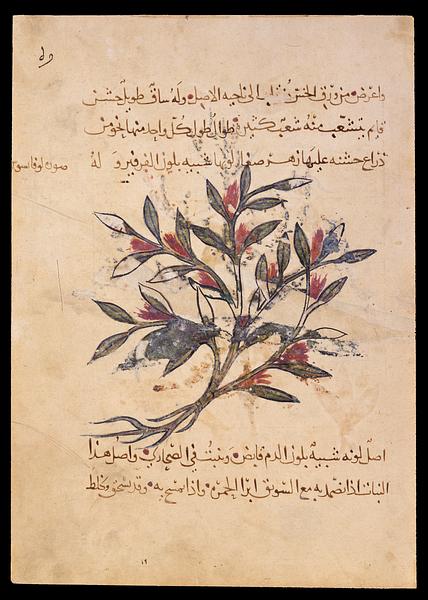Miniature from a copy of Kitab al-hashaish an Arabic translation of Dioscorides’s De Materia Medica. ‘Viper’s Bugloss’
Iraq, Baghdad (?); 1224
Leaf: 32.5 × 23 cm
Pharmacology in classical Arab culture can be said to have drawn on three major sources: popular medicine (both local Arab medicine and knowledge acquired from the peoples of conquered lands), translations of works about medicines from earlier cultures, and Arab physicians’ own observations and experiences.
This fragment, from a 13th-century transcription of Dioscorides’s De Materia Medica (written in the 1st century), contains a description of the herb luqabsus (from the Greek lykapsos), probably viper’s bugloss. In order to avoid misunderstandings and mistranslations, many medicinal plants were illustrated, and their Greek names were carefully transliterated into Arabic. This made it possible for those with a knowledge of Greek to verify and if necessary correct identifications of species. Manuscripts of this type are among the oldest with illustrations known from the Islamic cultural sphere.
Inv. no. 18/1988
Published in:
Edwin Binney: Persian and Indian miniatures from the Collection of Edwin Binney, 3rd, exhibited at the Portland Art Museum, September 28 -November 29, 1962, Portland Art Museum, Portland 1962, cat.no. 11;
Ernst J. Grube: Muslim miniature paintings from the XIII to XIX century from collections in the United States and Canada, catalogue of the exhibition, Istituto Venezia e l'Oriente, Venezia 1962, cat.no. 2;
Islamic art from the Collection of Edwin Binney 3rd, circulated by the Smithsonian Institution Traveling Exhibition Service, 1966-1968, [ed. Thomas C. Witherspoon], Washington 1966, fig. 17;
[B. W. Robinson et al.]: Persian and Mughal art, Colnaghi, London [1976], cat.no. 3:2 (mentioned);
Art from the World of Islam. 8th-18th century, Louisiana, Humlebæk 1987, cat.no. 103a;
Kjeld von Folsach: Islamic art. The David Collection, Copenhagen 1990, cat.no. 17;
Kjeld von Folsach, Torben Lundbæk and Peder Mortensen (eds.): Sultan, Shah and Great Mughal: the history and culture of the Islamic world, The National Museum, Copenhagen 1996, cat.no. 73;
Kjeld von Folsach: Art from the World of Islam in The David Collection, Copenhagen 2001, cat.no. 19;
Ahmed Djebbar (ed.): L'age d'or des sciences arabes, Institut du monde arabe, Paris 2005, cat.no. 108, p. 182;
Kjeld von Folsach: For the Privileged Few: Islamic Miniature Painting from The David Collection, Louisiana, Humlebæk 2007, cat.no. 1;
Hossam Elkhadem: À la découverte de l'age d'or des sciences arabes, catalogue de l'exposition itinérante, Université libre, Bruxelles, Bruxelles [2009], p. 99;
Stig T. Rasmussen: Klassisk arabisk litteratur i oversættelse til dansk: en litteraturhistorisk vejvisende antologi, København 2018, pp. 162-163;
